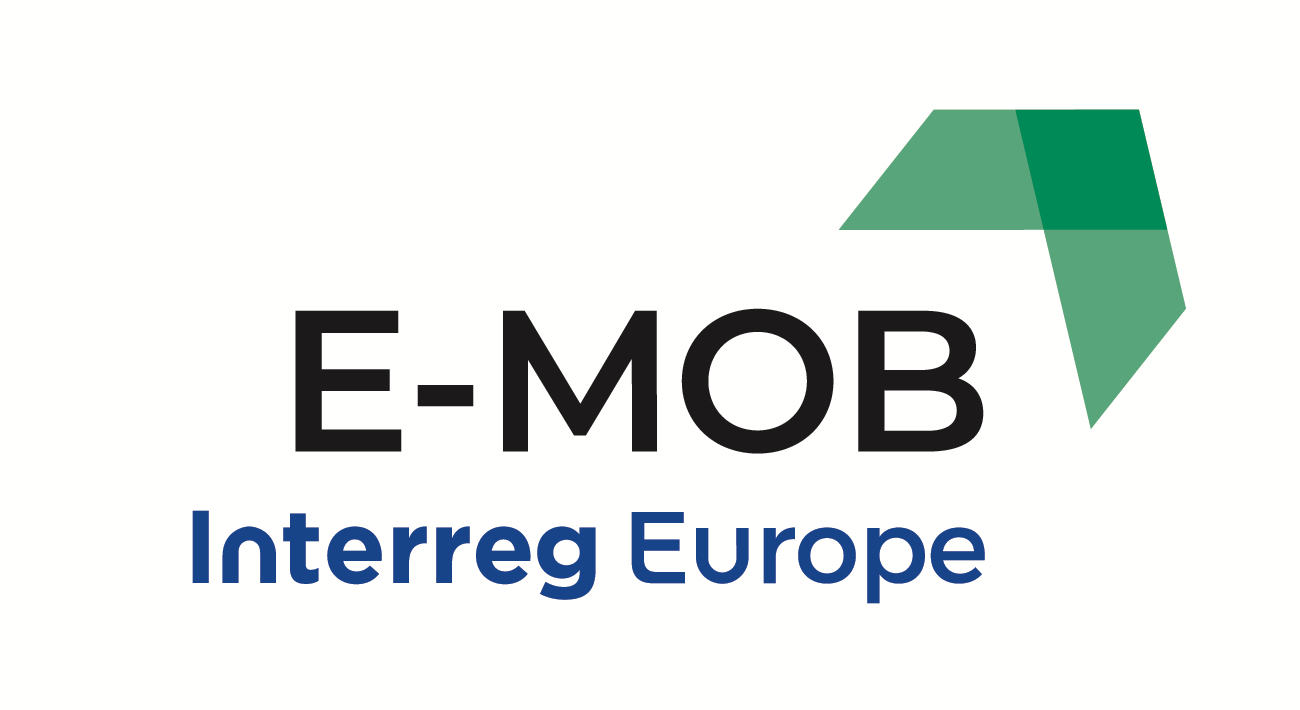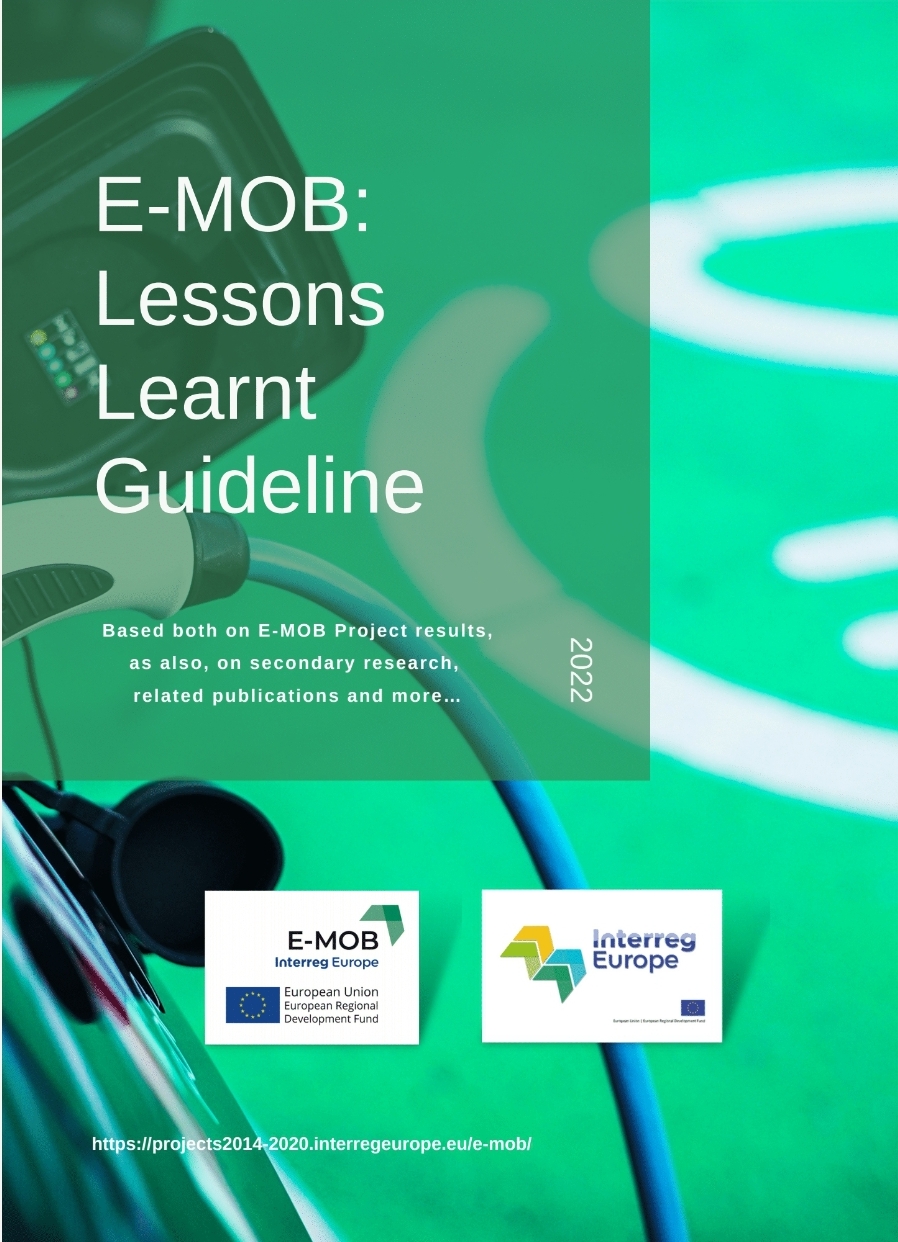
PRESS RELEASE
The high dissemination event of the Interreg Europe project E_MOB – „Integrated action towards enhanced e-mobility in European regions“ was held in Romania.
E-mobility has a great potential to improve our environment. Cars, trains and planes account for a quarter of global energy consumption and approximately the same proportion of emissions. That is a heavy load – but at the same also a unique chance to limit our impact on the climate. The 9 partners of the E-MOB project represent 8 European regions at different stages of e-mobility development, but they all share the view that e-mobility represents the future of mobility: a clean, quiet, advanced technology, combined with power, speed and lots of fun.
E-MOB stands for Integrated actions towards enhanced e-mobility in European Regions and aims at enhancing e-mobility solutions in regional passenger transport systems through coordinated policy learning and planning. As an ambitious target, the partners strive for influencing in total more than 26 million EUR of Structural and other Funds through 8 policy instruments to be revised in the frame of a series of peer reviews and learning conferences. Based on the outcomes of this interregional learning process (8 good practices and policy recommendations), the partners will jointly elaborate Action Plans for the improved implementation of the selected 4 Structural Fund Programmes and 4 other policy instruments. Actors of regional relevance will be involved in the whole procedure, being invited in the whole interregional learning and action planning process. The engagement of stakeholders will be facilitated by the establishment of 8 Regional Stakeholder Groups. Members of the RSG – together with interested municipalities – will also have the possibility to improve their capacities in turning the policies concerned into actions: Partners will elaborate the E-MOB Guideline and organise regional trainings in e-mobility strategic planning. This coordinated intraregional learning will contribute to plan and implement concrete measures and projects in the field of e-mobility, bringing tangible results to the participating regions.
€1,535,195.00
Low-carbon economy
The PI is: Investment Priority 7b: Enhancing regional mobility by connecting secondary & tertiary nodes to TENT (Trans European Transport Networks) infrastructure, including multimodal hubs. 2 priority axis are considered also, due to their strong connection with the PI addressed: PA3-Promoting the low-carbon economy through investments in energy efficiency in buildings, public lighting & sustainable multimodal urban mobility & PA 4-Supporting sustainable integrated urban development & regeneration of deprived urban areas. A specific objective is mostly concerned: PI 3.2 Promoting strategies to reduce CO2 emissions in particular urban areas, including promoting sustainable urban mobility plans & relevant measures to help adaptation. This is of high priority and will finance investments based on sustainable urban mobility plans. In line with EU CO2 reduction policies, the expected contribution to the mentioned objective in all urban areas, namely to support the transition to a low-carbon dioxide economy in all sectors, shall be provided by lowering exhaust emissions from transport, offering alternative transportation options & discouraging private car use, making cities better places to live for their inhabitants. The ROP should be improved in order to be more focused on sustainable mobility & urban quality of life (e.g. road and personal safety in urban transport, energy saving of transport modes) & promotion of new measures & technologies for the environment.
The action covers urban areas the beneficiaries being local public authorities.
3 action domains are targeted by priority axis 4 - Investment priority 4.1: investments to improve urban public transport (ex.purchase of EEV); investments for electric and non-motorized transport (ex.set up of electric transport infrastructure; other investments to reduce CO2 emissions in urban areas.
E-mobility being in Romania at the beginning, local authorities do not have real capacity and experience to elaborate strong project proposals in order to successfully apply for funding through the policy instrument. This policy instrument requires that the e-mobility intended measures to be well integrated into a comprehensive urban development strategy; consequently, local authorities need knowledge about good practice cases related to implemented e-mobility measures and learn through sharing experience with peers in the EU. Through well-tailored learning processes, local authorities should build capacity to apply for funding through the policy instrument with high quality and sustainable projects in order to lead to a substantial contribution to the reduction of CO2 emissions at local level.
The main policy instrument addressed in this is the “Elektromobilitätsstrategie Vorarlberg 2015-2020”. This document gave a framework for the development of e-mobility in the State of Vorarlberg. The document has to be improved and redefined for the following years including a clear analysis of the pros and cons of the measures, their impact in the last years and an integration of changed boundary conditions and newest developments within Europe. For reaching the ambitious goals of the state of Vorarlberg, it is essential to define clear and ambitious short- to midterm subgoals in terms of increasing e-mobility in Vorarlberg and, therefore, decreasing energy consumption and emissions. Hence, a clear pathway for 2020 to 2025 has to be defined by improving this policy instrument within the project. This pathway has to include an analysis of the interaction between electric vehicles and electric grid and recommendations for a joint expansion and development of e-mobility and infrastructure (loading devices, renewable energy generation, electric grid). Solely based on this information it is possible to give relative reduction goals for energy and emissions.
Local Strategy of Sustainable Integrated Urban development CIEZA 2025 INCLUSIVE CITY plans the improvement of local mobility within the thematic objective 4 - supporting the shift towards a low carbon economy, priority 4 e - Promotion of strategies of low carbon economy. Its general aim is to reduce the use of motor transport for local movements by increasing low carbon solutions at hand for its local population, such as cycling and pedestrian paths, smart parking solutions for access control and park-slots availability; and the promotion of electric mobility by placing charging statins on public parking and local streets. So that CO2 emissions will decrease.The development of charging infrastructures for electric vehicles, cars and motorcycles and light quadricycles will be the subject of the line 4.2. It will incorporate both slow and fast loading systems that will be managed by a load manager duly authorized.
This line of action doesn’t envision a previous study to create a wide network of charging facilities that will strength the implementation of this service. Furthermore, Local mobility plan, drafted on 2010, didn’t include as much electric mobility solutions as it could. The participation on E-MOB project will provide policy instrument with a Local action plan that will be able to embrace needs identified about electric mobility solutions. It will also provide to local staff with best practices and specific know-how about it.
Objective: ITOP focuses on improving the transportation sector of Hungary in terms of infrastructure, accessibility and reducing emission. These goals are assigned to four main priorities: improving international road accessibility, improving international railway accessibility, developing sustainable urban and suburban transport and lastly improving access to the TEN-T road network.
Charactistics:
ITOP focuses mainly on main infrastructure investments and is responsible for providing a framework for transport development of country and is actually based on the National Transport Strategy. On the grounds of TEN-T network are based the main infrastructure investments and EU2020 goals are addressed in terms of sustainable growth via reduced emissions, e-mobility and ICT solutions.
Priority concerned: National specific objective 3.A - Supporting sustainable public mobility - linked to ERDF Investment priority 4(e).
Reasons to improve: Though ITOP intends to deploy state-of-the-art solutions, innovation in the transport sector and e-mobility spreads quicker than it could be addressed in a policy framework designated to address a timeframe of 7 years, which could be improved by policy learning and transfer of good practices. In terms of sustainable transport development, the smart city concept gains ground. In order to improve transport between the city and the countryside, DRT services with even more sophisticated ICT solutions are being implemented.
The main goal is to make Leipzig one of the leading cities in the field of smart mobility. The main component here is an implementation concept for the promotion of e-mobility, which refers directly to the tasks "Sustainable Mobility" and "Sustainable Cluster and SME Promotion", which are defined in the work program of the Lord Mayor "Leipzig 2020". The following planned or already implemented deliverables are specifically pursued a.o.: the concept "car-poor inner city", the clean air plan, the cycling develop. plan, the energy & climate protection program of Leipzig 2014 – 2020, the urban develop. plan traffic and public space. The desired development of these measures is ensured by the Office for Economic Development and can be significantly influenced by the knowledge gained from the exchange and the action plan. The basis for these measures is the basic decision to promote intelligent mobility solutions. The implementation of this concept will allow the electrification of vehicles in Leipzig to be carried out at a gradual rate, thus making a significant contribution to reducing CO2 emissions in the transport sector. In addition, the quality of life will be significantly increased by the reduced emissions of pollutants, particulate matter and noise. E-mobility is one of a few industry-based development fields of Leipzig. Here, a variety of economic opportunities can open up, which will lead to the creation of new jobs and the stabilization of existing ones.
The objective of the ERDF-ESF Programme for Picardie is to boost economic growth and employment through logic energy transition and innovation. The 17.71% of the budget is allocated to low carbon economy initiatives, being one of the funding priorities the encouragement of low carbon economy (renewable energies, energy efficiency in buildings, housing and enterprises).
The region faces nowadays several challenges, and one of the most important is the acceleration of the decarbonisation of its territory before 2030. In this context, the transport sector will play a key role in the decarbonisation of the region. It represents almost a quarter of greenhouse gas emissions and it is the main cause of air pollution in European cities.
Amiens Metropole wants to address this challenge by improving of the above mentioned Policy Instrument, through the implementation of a low carbon mobility plan including energy storage innovative methodologies.
Amiens Metropole aims at supporting the local authorities from the region of Picardie/Hauts de France in their efforts towards the goal of achieving a sustainable mobility by promoting low-carbon mobility through an electric bus network and by bringing to the region the experience and know-how of all the partners involved in this Interreg Europe project. This will allow the development and implementation of new mobility concepts and plans, a more efficient and coordinated management and the deployment of innovative technologies.
The goal of this document is to boost the implementation of electric vehicles on the level of the City of Koprivnica. The current Sustainable urban mobility plan of the City of Koprivnica that was developed in 2015 has a chapter that is dedicated to the promotion of electromobility in Koprivnica. Because of the developments that occurred in the field of electric vehicles in the last couple of years, constant change and improvement of technologies, and therefore the increased need and requirement of local communities to better cope with the changes, an improved and up to date strategic document is needed in order to increase the capacity of the public authority, propose new actions regarding the support of electromobility from a local point of view and to see what are the potential opportunities and threats in this process. The document will be developed in line with the upcoming EU guidelines on SUMPs where electromobility will play an important role. It will serve the City of Koprivnica as a background to implement new electromobility actions in Koprivnica, mostly regarding the encouragement of the uptake of electric vehicles and, as a very important topic for local communities, guideline how to plan a charging infrastructure.
The document will be prepared by the “Electric vehicle competence and experience centre”, an informal organisation set up by the City of Koprivnica and that has the goal of promoting the usage of electric vehicles in Croatia.

The high dissemination event of the Interreg Europe project E_MOB – „Integrated action towards enhanced e-mobility in European regions“ was held in Romania.

At the end of the first phase of the project, "E-MOB: Lessons Learnt Guideline" were prepared, which will soon see the light of day. Thus, the project moves int

6th partner meeting was helded in in Leipzig, which took place from June 27, 2022, until June 28, 2022.

The Emob project partner from Greece participated in a conference called Greenmobility conference 2022 held in Kozani, Greece
The fifth partner meeting was held on January 26, 2022. online

2008 Vorarlberg decided to cover 100% of its energy needs from renewables by 2050 including the whole mobility sector and by then is working on its developmet.
6th peer review was held in Koprivnica via an online platform during the COVID-19 pandemic.
On the 4 th of November 2021, PP5-University of Western Macedonia presented E-MOB project and its Good practices at the final event of Optitrans project, after

Another partner meeting was held on the E-MOB project. The partner meeting was held online due to the COVID-19 pandemic.

The fifth regional stakeholder meeting took place on April 14, 2021, in the rooms of Aufbauwerk.